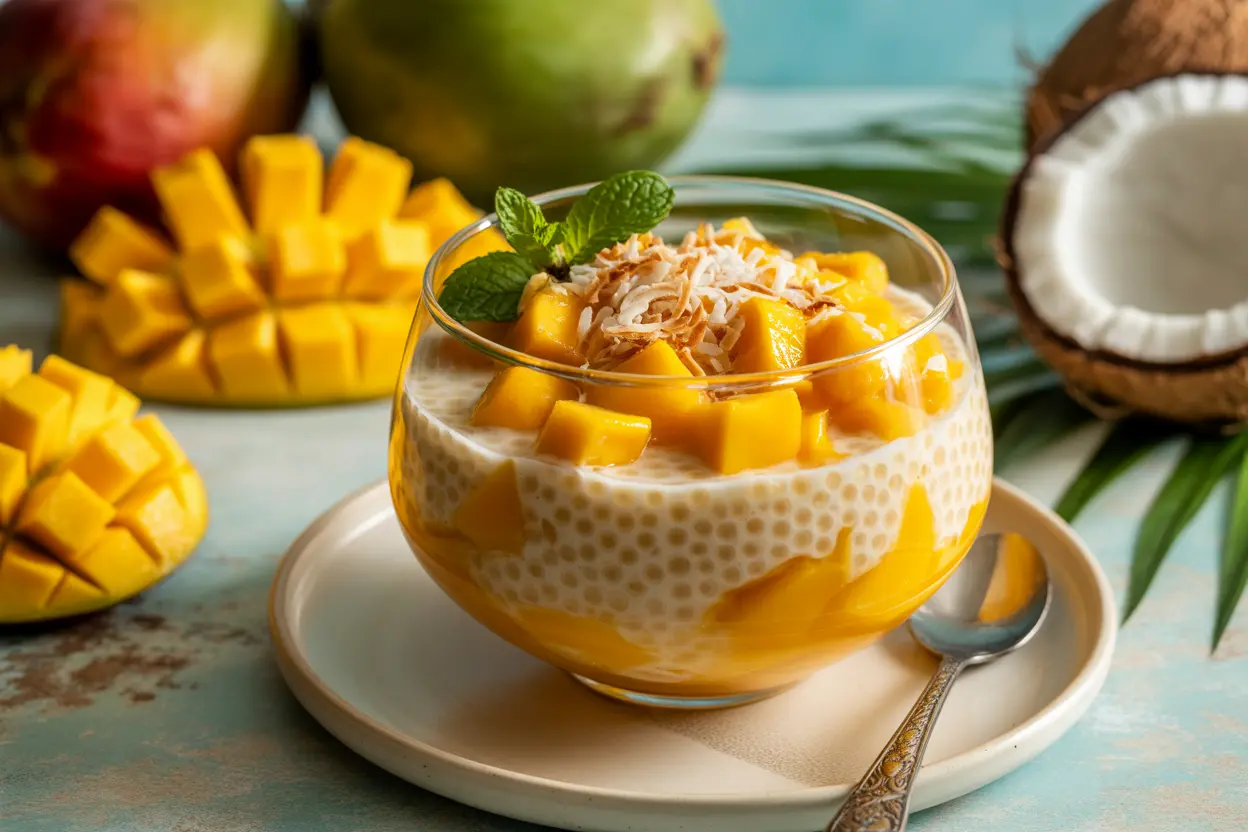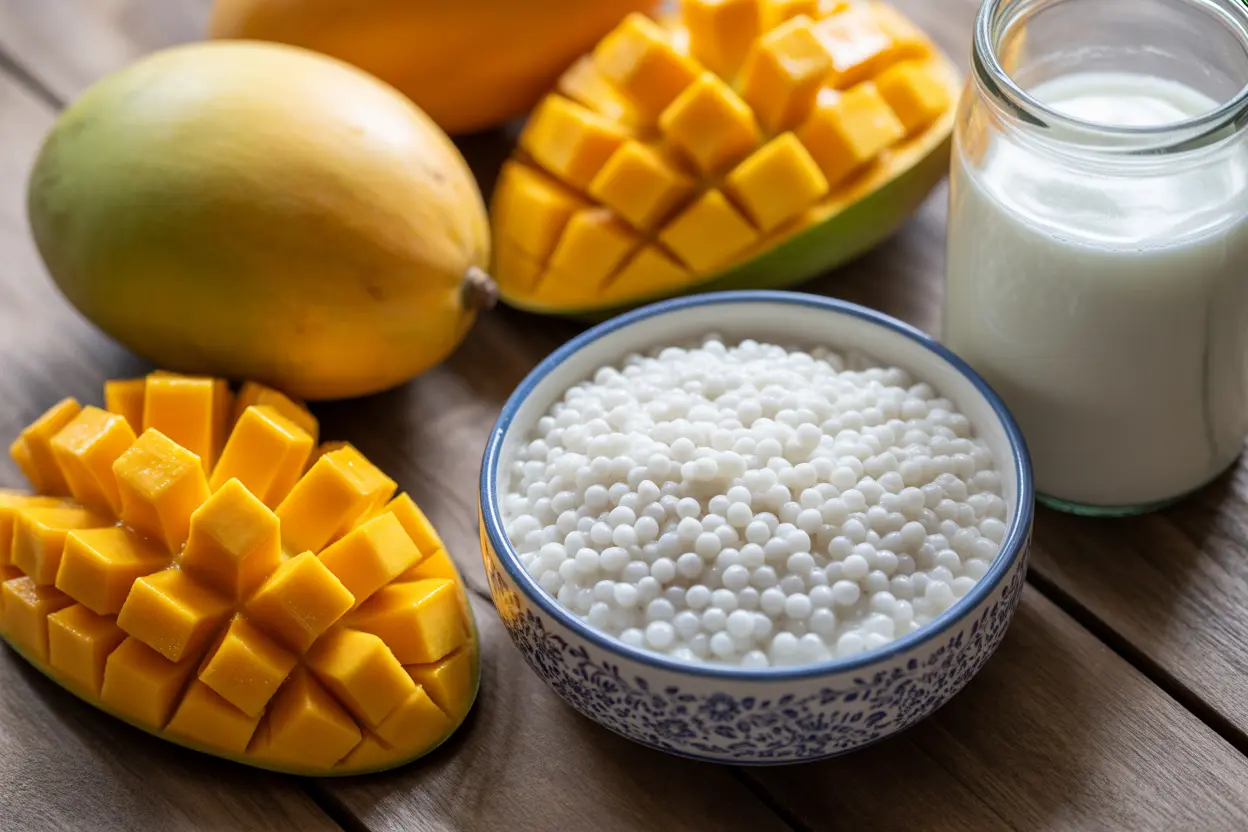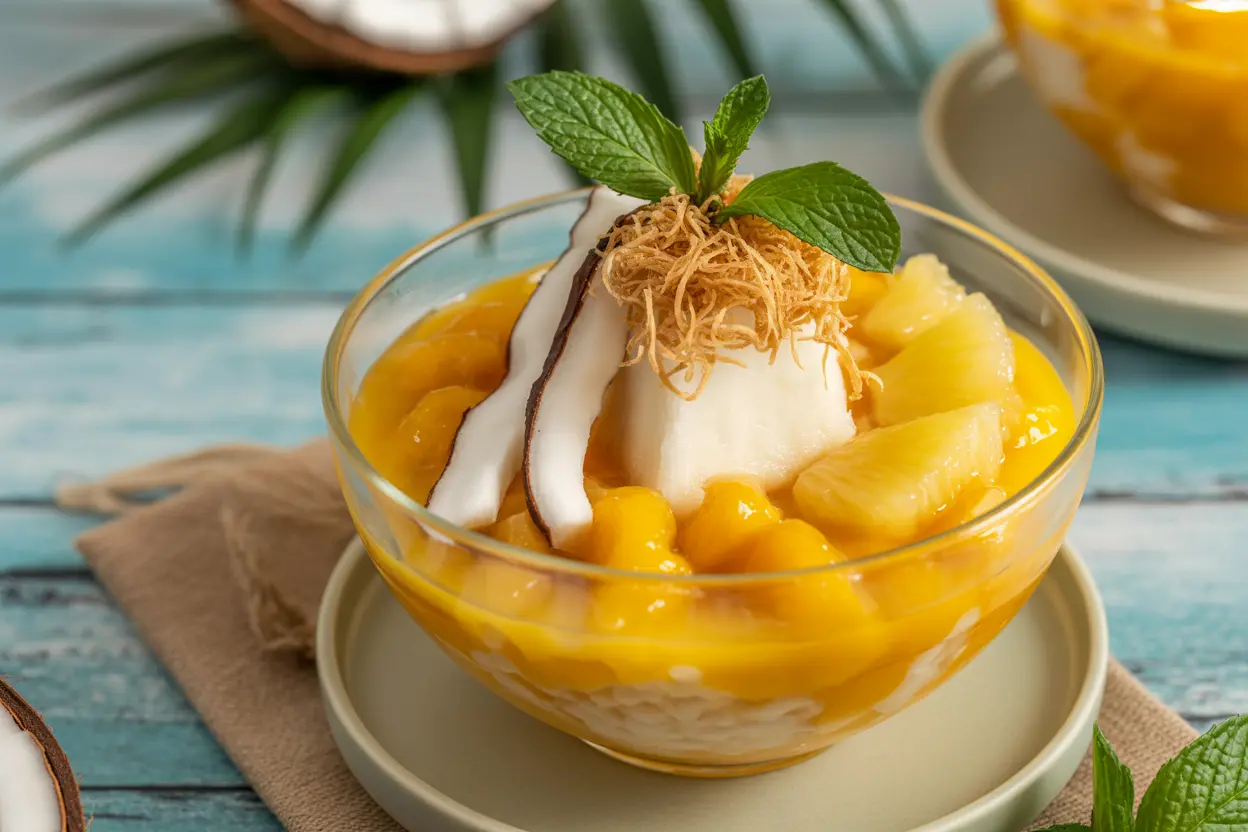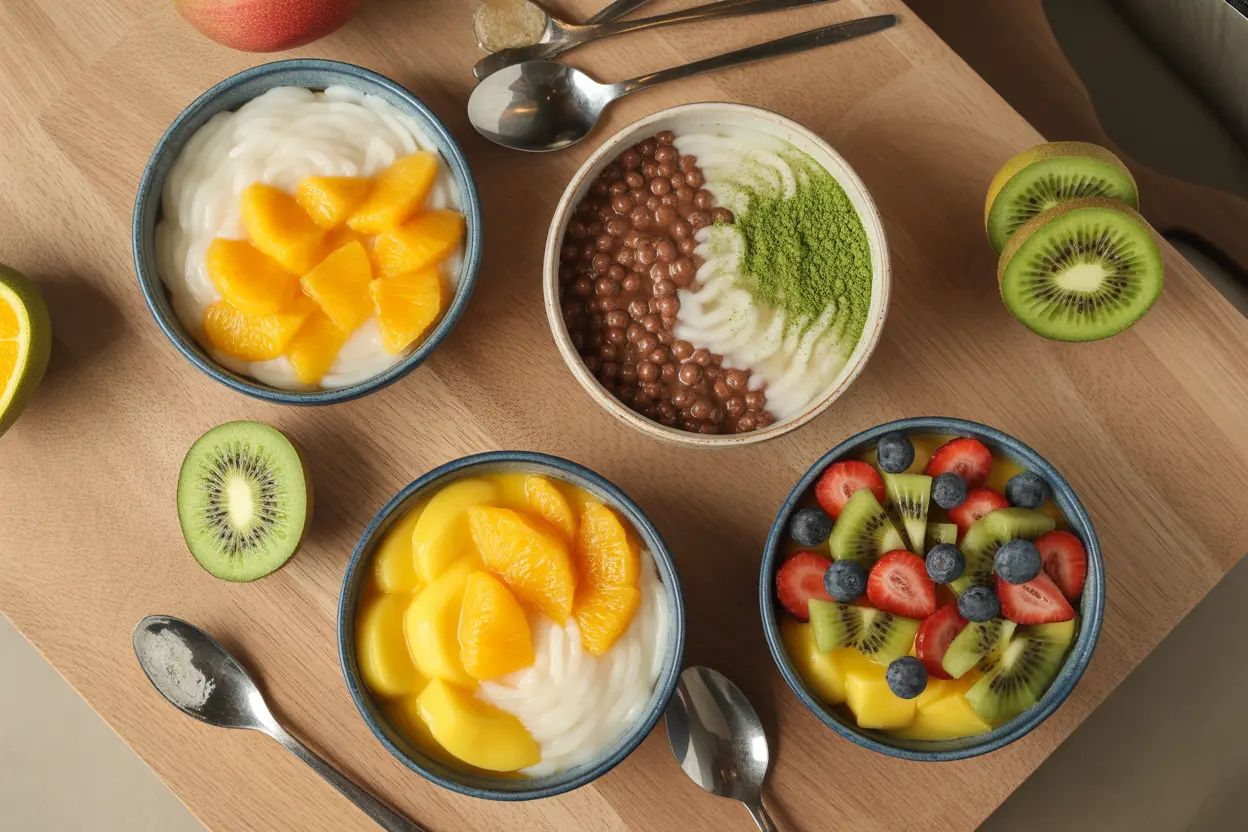Introduction to Mango Sago
What is Mango Sago?
Mango sago is a beloved Asian dessert famous for combining fresh ripe mango sweetness with chewy sago pearls showered in creamy coconut milk. Wondering what exactly makes this dessert so irresistible? Essentially, it’s a chilled, fruity pudding that brings together tropical flavors and satisfying textures. If you’ve ever tasted a traditional Chinese dessert or a Cantonese dessert in the summer, chances are you experienced mango sago’s delightful charm. For an easy mango sago dessert, the interplay between the mango’s natural juicy sweetness and the pearls’ comforting chewiness creates a harmonious tropical rhythm.

Popularity and Regional Variations
Mango sago’s popularity stretches beyond Hong Kong to many parts of Asia and the world, where it has been reimagined with exciting twists. For example, in some regions, you might encounter mango pomelo sago, adding a citrusy zing that awakens the palate. These regional takes showcase how versatile this dessert really is. You can explore more about this tropical fruit dessert and its global variations here. If you want to dive deeper into authentic tropical flavors, check out this authentic tropical dessert guide that further celebrates mango sago’s essence.
Core Ingredients of Mango Sago
Fresh Ripe Mangoes: Varieties and Selection
When making a mango sago dessert recipe, the star ingredient is unquestionably the mango. Picking the right mango variety can make or break the flavor and texture of your dessert. Popular varieties include Alphonso mango, known for its rich sweetness and vibrant color; Ataulfo mango, which offers a creamy texture; and Honey mango, famous for its tropical fragrance. Each brings a distinct personality to the dish, so choosing very ripe, fragrant mangoes is key. Look for mangoes that yield slightly to gentle pressure and emit a sweet aroma – these are ripe and juicy, perfect for chopping into fresh mango cubes or making luscious mango puree.

Sago Pearls vs. Tapioca Pearls
Sago pearls are tiny starch balls derived from the pith of the sago palm, while tapioca pearls come from the cassava root. Both provide that chewy texture essential to mango sago, but they differ slightly in size and cooking time. Mini tapioca pearls are often used interchangeably with sago pearls; however, sago pearls typically cook faster and have a slightly firmer bite. Since texture is everything here, it’s good to understand which you prefer. Cooking sago pearls perfectly takes practice; undercooked pearls are hard, and overcooked ones get mushy. Want a step-by-step look at authentic mango sago preparation? Try this traditional mango sago with evaporated milk, which uses similar pearls.
Coconut Milk and Cream: Types and Uses
No mango sago dessert recipe is complete without the rich creaminess of coconut milk or cream. Coconut milk adds a natural sweetness and velvety mouthfeel that balances the fruity brightness of mangoes and the chewy pearls. Depending on your preference, you might use full-fat coconut milk for a decadent finish, or coconut cream for an even richer texture. Some recipes blend coconut milk with sweetened condensed milk to add extra sweetness and body. These dairy-free ingredients make mango sago naturally gluten-free and a fan favorite among those seeking rich, tropical flavors. For more on combining these dairy delights, explore the authentic tropical dessert techniques.
Sweeteners and Flavor Enhancers
Condensed Milk and Alternatives
Sweetening mango sago traditionally involves sweetened condensed milk, which blends sweetness with creamy richness effortlessly. It’s a surprisingly versatile ingredient, lending the dessert depth and smoothness without overpowering the natural mango sweetness. If you’re after a slightly lighter or dairy-free twist, you might consider evaporated milk combined with your choice of sweetener, or vegan condensed milk alternatives. A simple mango sago recipe often balances the richness of condensed milk with fresh mangoes to avoid an overly heavy dish. Curious about incorporating other bold flavors? This guide on flavorful herb garlic butter shows how subtle flavors can transform dishes—imagine similar thoughtful flavor boosts in dessert!
Other Sweeteners: Honey, Maple Syrup, and Sugar
Of course, not everyone wants the exact taste of condensed milk. Honey and maple syrup are excellent natural alternatives that provide floral and caramel-like notes, respectively. They dissolve easily into the coconut milk mix, making the dessert pleasantly sweet without artificial aftertaste. Cane sugar or simple syrup also works well if you want a straightforward sweetness, easily adjusted to your taste preferences.
Adding a Pinch of Salt and Other Flavor Boosters
A little-known trick to kick your mango sago up a notch is adding a pinch of salt. Salt enhances the sweetness and balances richness, almost like magic seasoning for desserts. Some also add fresh lime juice or vanilla extract for a tangy or aromatic lift, making your mango sago experience uniquely refreshing.
Optional and Modern Additions
Coconut Jelly (Nata de Coco) and Other Textural Elements
To add delightful chewiness beyond sago pearls, many modern mango sago recipes incorporate coconut jelly, known as nata de coco. This translucent, slightly crunchy jelly adds a fun contrast to the creamy and fruity dessert base. It’s a popular addition that provides variety in texture and a subtle coconut flavor. For more creative mango sago dessert ideas, including those with nata de coco variations, check out this creative mango sago dessert ideas.

Alternative Milks: Oat, Almond, and Plant-based Options
For those seeking plant-based or nutty alternatives, oat milk, almond milk, or other plant-based milk options can replace coconut milk or cream. These variations can create a lighter or subtly different flavor profile that appeals to diverse dietary needs. Combining plant milks with natural sweeteners can give you a fabulous vegan mango sago experience without losing creaminess.
Garnishes: Toasted Coconut Flakes, Fresh Mint, and More
To elevate your mango sago visually and in flavor, consider garnishing with toasted coconut flakes—offering a slight crunch and nutty aroma. Fresh mint leaves add a surprising pop of freshness and a green contrast that wakes up the senses. Some even sprinkle chia seeds or crushed nuts for extra texture. Want tips on keeping mango sago fresh? See these storage tips for mango sago.
Common Mango Sago Variations
Mango Pomelo Sago and Citrus Variants
One classic variation is mango pomelo sago, where juicy pomelo segments introduce a burst of citrusy brightness, cutting through the creamy dessert’s richness. This combo is incredibly popular in Cantonese cuisine and offers a flavor complexity that feels both refreshing and indulgent. Other citrus fruits like lime zest or orange segments may also be added to achieve this exciting contrast.
Fruit Mix-ins: Berries and Others
If you love experimentation, adding berries like blueberries or raspberries to a mango sago pudding can lend a tart sweetness that pairs exceptionally well with mango. Kiwi, pineapple, or even pomegranate seeds can be tossed in for color and zing, creating a vibrant fruit-based dessert that celebrates freshness.
Unique Twists: Matcha, Chocolate, and Sticky Rice Balls
For more adventurous palates, fusion recipes introduce matcha powder, giving an earthy tone that complements the fruity mango. Chocolate lovers might enjoy cocoa drizzle or chocolate tapioca pearls for a playful contrast. Sticky rice balls, reminiscent of other Asian desserts, also serve as delightful additions in mango sago, blending chewiness with flavor bursts.

Preparation Tips and Ingredient Quality
Selecting and Preparing Sago Pearls
Perfectly cooked sago pearls are crucial. Soak them briefly, then boil until translucent and chewy. Rinse under cold water to remove excess starch and prevent clumping. Cooking times vary between brands and types but usually ranges from 10-20 minutes. Planning ahead and tasting frequently helps ensure your pearls stay just-right for that ideal mango sago preparation.
Choosing the Best Mangoes for Flavor and Texture
Always go for fragrant, ripe mangoes that yield to gentle touch without bruises. The quality of mango affects sweetness, juiciness, and ultimately your dessert’s success. Using mango puree or fresh mango cubes both work wonderfully, depending on your preferred texture.
Combining Ingredients for Optimal Texture and Taste
Balance is the name of the game. Mix the sago pearls with coconut milk and condensed milk gently, then fold in mango without mashing. Chill sufficiently – mango sago shines when served cold. This ensures creamy richness meets the refreshing snap of fruit.
Nutritional Aspects and Dietary Modifications
Nutritional Profile of Mango Sago
Mango sago packs a nutritional punch with mango providing vitamins A, C, and fiber. Coconut milk adds healthy fats, while sago pearls contribute carbohydrates for energy. While delicious and satisfying, the dessert can be calorie-dense due to sweetened condensed milk, so portion control is key.
Vegan, Dairy-free, and Low-sugar Alternatives
Looking for vegan mango sago? Swap condensed milk for coconut cream or almond-based condensed milk alternatives and sweeten with maple syrup or honey to keep it natural and dairy-free. You can adjust sweetness to keep it low-sugar while still enjoying a creamy, tropical dessert. For inspiration on balanced meals, explore these nutritious and delicious pairings.
FAQs
What are the basic ingredients needed for mango sago?
The fundamental ingredients for a mango sago dessert recipe include fresh ripe mango (either in cubes or puree), sago pearls (or mini tapioca pearls), and coconut milk or cream. Sweetened condensed milk or an alternative sweetener like honey or maple syrup is typically used to enhance the flavor and creaminess. Some recipes add a pinch of salt or flavor enhancers for balance. These basics create a rich, tropical, and delightfully textured dessert.
Can I use tapioca pearls instead of sago pearls?
Absolutely! Tapioca pearls are commonly used as a substitute for sago pearls in mango sago desserts because both provide the chewy texture that this dish is known for. Tapioca pearls tend to be slightly larger and may require a slightly longer cooking time, but mini tapioca pearls work great too. Many recipe enthusiasts use tapioca pearls interchangeably. For more details on cooking pearls, see this easy mango sago dessert.
What types of mangoes are best for mango sago?
Ideal mangoes for mango sago are those that are ripe, fragrant, and sweet. Alphonso mangoes are often considered the gold standard thanks to their intense sweetness and flavor. Ataulfo mangoes have a buttery texture perfect for creamy desserts, while Honey mangoes offer fruity floral notes. Fresh mango cubes should be soft enough to eat easily but not mushy. The better the mango quality, the more vibrant and flavorful your dessert will be.
Are there vegan substitutes for condensed milk in mango sago?
Yes! You can use coconut cream sweetened with maple syrup or agave nectar as vegan alternatives to condensed milk. There are also commercially available vegan condensed milk brands made from nuts or soy. Using plant-based milks like almond or oat milk combined with natural sweeteners will create a delicious vegan mango sago that retains creamy texture without dairy.
How do I make mango sago more refreshing in the summer?
Serve your mango sago well chilled or with a few ice cubes for an extra cool treat. Incorporate citrus fruits like pomelo or lime juice to add brightness. Adding fresh mint or toasted coconut flakes as garnish also enhances its refreshing quality. You can also lighten the dessert by using less condensed milk or swapping part of the coconut milk for cold water or plant-based milks.
What are some popular variations of mango sago dessert?
Popular variations include mango pomelo sago, which adds citrus segments for tanginess, and fruit mix-ins like berries or kiwi for color and flavor. Unique twists involve adding matcha powder, chocolate toppings, or sticky rice balls for texture contrast. Some recipes incorporate nata de coco or coconut jelly to enhance chewiness. These versions showcase how mango sago can be reinvented while keeping its tropical roots. Discover more refreshing mango tapioca pudding ideas.
Conclusion
Mango Sago is a beloved and versatile Asian dessert centered around key ingredients such as fresh ripe mango, sago or tapioca pearls, and creamy coconut milk blended with sweetened condensed milk or alternatives. Understanding the ingredient options, common variations, and preparation tips can empower cooks to create delicious, refreshing mango sago desserts that cater to different dietary preferences. Whether served traditionally or with modern twists—like nata de coco or matcha infusions—this dessert remains a tropical favorite that celebrates natural fruit flavors and rich textures, perfect for any sunny day or festive occasion.
